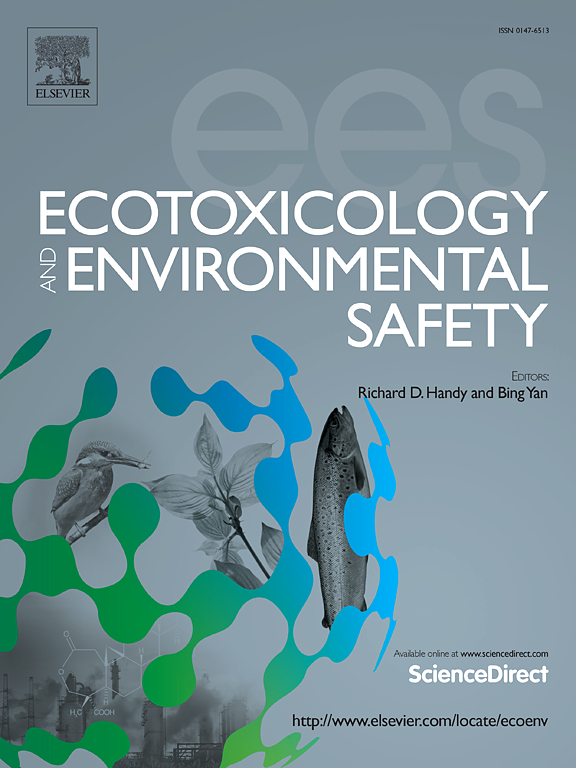网络毒理学与分子对接探讨双酚A对人糖尿病心肌病的毒性作用机制
IF 6.2
2区 环境科学与生态学
Q1 ENVIRONMENTAL SCIENCES
引用次数: 0
摘要
双酚A (BPA)是一种无处不在的干扰内分泌的化学物质,广泛用于聚合物、增塑剂和食品包装,引起了对人类健康的重大关注。越来越多的证据表明BPA暴露与心血管疾病有关,包括糖尿病性心肌病(DCM),一种以心肌功能障碍为特征的糖尿病严重并发症。本研究采用网络毒理学和分子对接相结合的综合方法,阐明bpa诱导DCM的分子机制。利用ADMETlab2.0、ProTox3.0、GeneCards、OMIM、Swiss Target Prediction、ChEMBL数据库等计算工具,系统预测了BPA诱导DCM的可能性,并构建了全面的疾病和BPA靶标文库。Venn图分析确定了与BPA诱导的DCM相关的93个潜在靶点,并利用Cytoscape建立了一个强大的BPA调控网络。功能富集分析揭示了氧化应激、胰岛素信号和代谢途径在BPA毒性中的重要作用。分子对接模拟表明,BPA与核心靶点(INS、AKT1、PPARG、STAT3、PPARA、MMP9)之间具有稳定的结合相互作用,结合能范围为−5.3 ~−7.5 kcal/mol。我们的研究结果表明,BPA可能通过cGMP - PKG信号通路、胰岛素信号通路、AMPK信号通路和HIF - 1信号通路等关键基因和途径诱导DCM。该研究为理解bpa诱导的DCM的分子发病机制提供了一个新的理论框架,并强调了网络毒理学在识别未表征的环境化合物的毒性途径方面的潜力。这些见解为bpa相关心血管并发症的预防和治疗策略提供了潜在的靶点。本文章由计算机程序翻译,如有差异,请以英文原文为准。
Network toxicology and molecular docking to investigate the mechanism of bisphenol A toxicity in human diabetic cardiomyopathy
Bisphenol A (BPA), a ubiquitous endocrine-disrupting chemical, is widely used in polymers, plasticizers, and food packaging, raising significant concerns for human health. Growing evidence links BPA exposure to cardiovascular diseases, including diabetic cardiomyopathy (DCM), a severe complication of diabetes characterized by myocardial dysfunction. This study employs an integrative approach combining network toxicology and molecular docking to elucidate the molecular mechanisms underlying BPA-induced DCM. Using computational tools such as ADMETlab2.0, ProTox3.0, GeneCards, OMIM, Swiss Target Prediction, and ChEMBL databases, we systematically predicted BPA's potential to induce DCM and constructed comprehensive disease and BPA target libraries. Venn diagram analysis identified 93 potential targets associated with BPA-induced DCM, and a robust BPA regulatory network was established using Cytoscape. Functional enrichment analyses revealed significant involvement of oxidative stress, insulin signaling, and metabolic pathways in BPA toxicity. Molecular docking simulations demonstrated stable binding interactions between BPA and core targets (INS, AKT1, PPARG, STAT3, PPARA, MMP9), with binding energies ranging from −5.3 to −7.5 kcal/mol. Our findings indicate that BPA may induce DCM through key genes and pathways, including cGMP−PKG signaling pathway, insulin signaling pathway, AMPK signaling pathway, and HIF−1 signaling pathway. This study provides a novel theoretical framework for understanding the molecular pathogenesis of BPA-induced DCM and highlights the potential of network toxicology in identifying toxic pathways for uncharacterized environmental compounds. These insights offer potential targets for preventive and therapeutic strategies against BPA-associated cardiovascular complications.
求助全文
通过发布文献求助,成功后即可免费获取论文全文。
去求助
来源期刊
CiteScore
12.10
自引率
5.90%
发文量
1234
审稿时长
88 days
期刊介绍:
Ecotoxicology and Environmental Safety is a multi-disciplinary journal that focuses on understanding the exposure and effects of environmental contamination on organisms including human health. The scope of the journal covers three main themes. The topics within these themes, indicated below, include (but are not limited to) the following: Ecotoxicology、Environmental Chemistry、Environmental Safety etc.

 求助内容:
求助内容: 应助结果提醒方式:
应助结果提醒方式:


